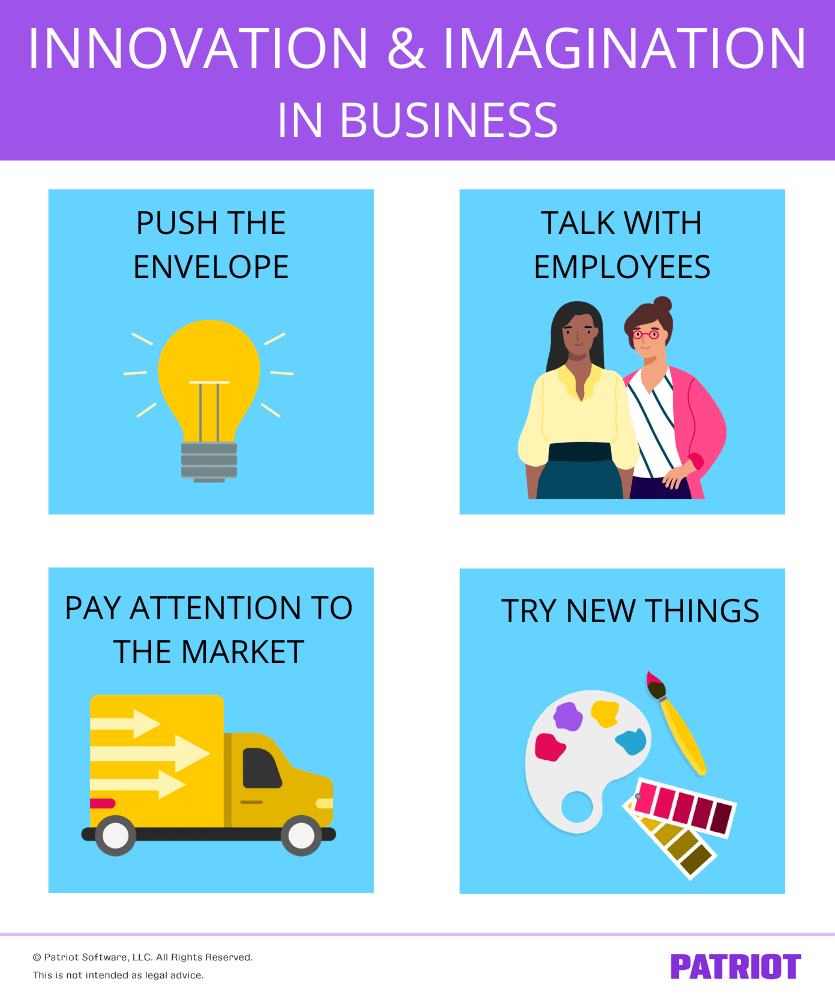If you can dream it, you can do it. For many, nothing could be more true. That’s why imagination and innovation in business are essential. Without them, your company could grow stagnant, become outdated, struggle to build business resilience, and fail to reach its full potential.
Need more convincing on why innovation and imagination are important? Want to learn how to be imaginative and innovative in business? Read on to find out.
Why innovation and imagination in business matter
People lose interest … fast. The last thing you want is for your customers to get bored with your business and what you offer. With a dash of imagination and innovation, you can spice things up and keep your customers invested.
But, innovation does so much more than maintain your customers’ interest. Coming up with new products and services isn’t the only way you can innovate.
Innovation is also key when it comes to things like:
- Streamlining business processes
- How can I accomplish this without so much effort?
- Cutting business expenses
- Is there a less pricey way I can get this done?
- Dealing with supply limitations
- What can I do to continue operations if there are supply chain disruptions?
- Finding new ways to market
- Is this a more effective way to reach my customers and get them to buy?
- Hiring new employees
- Can I expand my candidate pool by hiring remote employees?
- Changing up how customers can shop
- Should I offer an online shopping experience?
- Adapting to things beyond your control
- Because of COVID-19, people want contact-free options … should I try delivery?
When discussing the importance of innovation and imagination, Bart Turczynski of ResumeLab says:
Innovation is the fuel that continuously rekindles the fire of your competitiveness. If you want growth, creativity is essential to discover new, more efficient ways of doing things. Thus, the race never stops, as it is through imagination that you reinvent the wheel (or create something new altogether) to stay one step ahead of the competition.”
Pursuing imagination and innovation in business
Want to add a little imagination and innovation into your business? Check out the following tips to get started.

1. Don’t be afraid to push the envelope
If you want innovation in business, you have to commit. Being afraid to change the status quo or worrying about “risking a good thing” doesn’t bode well for innovation.
Rather than thinking about what could happen in a negative light, consider all the possible positives. Think about the increased productivity, business revenue, or time-savings that could come when you push the envelope.
Of course, doing your research and weighing the pros and cons is always critical before making any new business decisions. But at some point, you have to stop calculating all the possible outcomes and start doing.
2. Pay attention to the market
Struggling to innovate? You’re not alone. Coming up with creative ideas for your business is challenging for many business owners.
For inspiration, pay attention to the market. What’s trending? What do consumers like? What are your competitors doing?
Conduct a market analysis to learn about the dynamics of the market. Your market analysis could be a source of inspiration to learn what customers want and need.
3. Talk with employees
Who better to help you come up with ideas than the people who work in your business? Get employees in on the brainstorming. Set up meetings, create an idea board, and encourage employees to share suggestions.
Some ideas might be off-the-wall. And that’s OK! The point of imagination in business is to think outside the box and try things that are a little out there. At the same time, you don’t want to try something that clashes with your business’s brand.
To avoid implementing an idea that has nothing to do with your business, use the following documents to see whether it’s reasonable:
- Mission statement
- SWOT analysis for small business
- Vision statement
- Business plan
4. Try and test new things
After coming up with some creative ideas, it’s time to test things out. When it comes to innovation, you don’t have to fully commit to the things you’re testing … most of the time. The key is to measure.
Depending on the situation, you can measure how effective your innovative ideas are by:
- Conducting A/B tests
- Keeping up-to-date accounting records
- Gauging customer feedback
- Timing how long new processes take you



